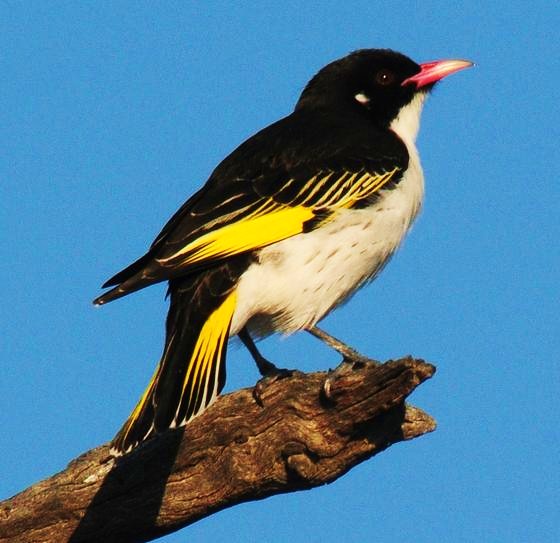Grantiella picta
 |
| (Photo from Flickr) |
Common name:
painted honeyeater (en); melífago-pintado (pt); méliphage peint (fr); mielero pintado (es); granthonigfresser (de)
Taxonomy:
Order Passeriformes
Family Meliphagidae
Range:
The painted honeyeater is endemic to mainland Australia, being found in Queensland and New South Wales west of the Great Dividing Range, through to northern Victoria. It is also found occasionally in the Northern Territory.
Size:
These birds are 14-17 cm long and weigh 18-25 g.
Habitat:
The painted honeyeater is mostly found in dry, open forests dominated by Acacia or Eucalyptus. During the breeding season they generally occur in areas with flowering and fruiting mistletoes and eucalypts.
Diet:
Their diet primarily consists of the fruit of Amyema mistletoes, occasionally also eating nectar and insects.
Breeding:
Painted honeyeaters breed in August-February. They breed in loose colonies, forming pair bonds for the duration of the breeding season. Both sexes build the thin, cup-shaped nest from grass and fine roots bound with spiderweb, which hangs by the rim from branches in the drooping outer foliage of trees, 2-20 m above the ground. There the female lays 2 eggs which are incubated by both parents for 13-15 days. The chicks are cared for by both parents and fledge 14-20 days after hatching. Each pair raises 1-2 broods per season.
Conservation:
IUCN status – VU (Vulnerable)
This species has a relatively large breeding range, but it is patchily distributed and the global population is estimated at just 2.500-10.000 individuals. The population is currently declining, mostly due to habitat conversion. Much of its breeding habitat has been cleared altogether or has been reduced to ageing, widely-spaced trees, particularly box-ironbark and boree woodlands and the non-breeding habitat is still being cleared for agriculture and habitat remnants in both the breeding and non-breeding ranges continue to be degraded by grazing.







